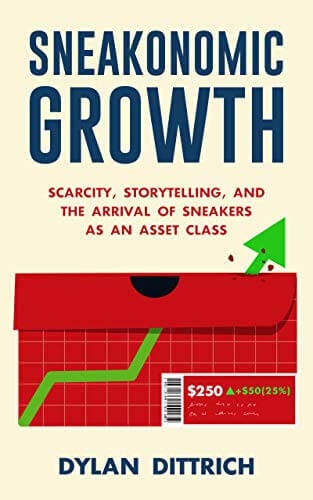![]()
Dylan Dittrich works in the world of finance, and has rigorously focused on investment management and research. While loafers and oxfords are the requisite footwear in his field, he is utterly fascinated by sneakers, owing not only to the fresh kicks, but also the economic, financial, and competitive forces shaping the sneaker economy.
After releasing my book, Nike’s Consumer Direct Offense, Amazon and StockX: The Disruption of Sneaker Retail, I was contacted by Portland Business Journal reporter Matthew Kish who asked if I had read the book Sneakonomic Growth by Dylan Dittrich. I replied that I hadn’t and thanked him for the heads up.
When I wrote my book I stated clearly that my goal was to inspire more books on the sneaker industry from those who are active participants in the culture and community. When I initially wrote the ebook version of my text last year, I sent it out to a number of people who are interviewed in Dylan’s book. I dove into Sneakonomics with a bit of bias because I assumed that quite possibly Dylan had run across my ebook. I thought this because I took a quick look through the table of contents and skimmed the book; it seemed that the contents of my ebook and Dittrich’s book were similar from a cursory glance.
As I began to read Dylan’s Sneakonomic Growth, I realized that we were pulling information from similar sources and that the shared information of what is happening in the sneaker industry is pretty much common knowledge. Diving into Sneakonomic revealed a completely different book than my own. My ebook was similar, but it was only a frame for the work that I placed into completing the longer more developed discussion. The only thing connecting Dylan’s work with my own was the industry.
Dylan had to, just as I had to do in my book, set a baseline. His information was predicated upon establishing how sneakers are not in the same class of collectible items like Beanie Babies or Baseball Cards. He took the time to explain how the collecting of sneakers may be closely related to the buying and selling of baseball cards, but with the data available in the sneaker market ‘collecting’ has morped into a serious business worth billions, while baseball cards and Beanie Babies lack the ecosystem to be seriously considered as investment opportunities.
Repacking information on collectibles as assets in a new and informative manner was his goal and I have to say that Dylan accomplished the initial concept of the book. He was able to establish how and why sneakers can be considered assets. However, because I was so close to the subject matter, and because I entered the book with bias, all I could read initially was that Sneakonomic is a book that delivers the aggregation of articles and content from across popular websites to explain the story of resale as it relates to sneakers. My first read was hindered because I was looking for similarities. Once I reread the earlier chapters my mind opened.
The initial chapters of the book read like the writing of a person in finance discussing kicks. The information on how the stock market works is reinforced with definitions of terms from the stock market and then Dittrich adds explanations from the creators of third party platforms. As the book transitions into the discussions on why this market isn’t going anywhere, the familiar discussions on GOAT, StockX and Stadium Goods become more prominent. Ultimately the book culminates with sections on influencers and how the sneaker industry has created jobs for those passionate about kicks. It’s a solid read and if a class curriculum was being created to teach people who aren’t familiar with why the sneaker industry is demanding so much attention, then this book would be a welcomed text because it definitely delivers an informative and entertaining introduction to the sneaker market.
In other words, I entered into the book a hater. I finished the book an admirer. I recommend Sneakonomics without any thoughts of overlap because while we both touch on the importance of StockX, Dylan’s book is written from the point of view of someone who isn’t as intricately involved in the day to day business of writing about and selling kicks. My book is written with the experience of having launched my own sneaker companies and operating one of the biggest online stores on Amazon and how my experience in encountering the shift in the digital marketplace informs my thoughts on how retail will have to respond to the impending battle against the brands they are carrying. Sneakonomics is an informative introduction and my book is problem and solution. Amazon isn’t mentioned at all in Sneakonomics.
I wanted more books on the business of sneakers and Sneakonomics isn’t remotely close to my own writing. It’s a completely different discussion, rooted in finance and the more hyped, mainstream sneaker industry. The book definitely adds to the growing cannon of business writing on an industry that can inform any analysis dealing with the sneaker business.
Buy Sneakonomic Growth on Amazon:
Sneakonomic Growth by Dylan Dittrich


